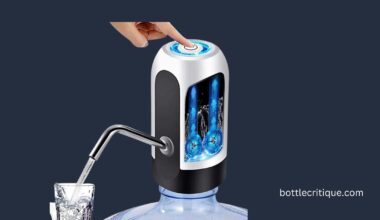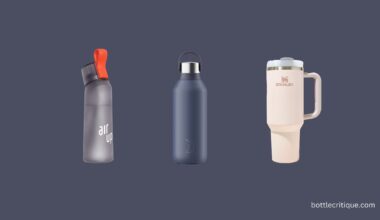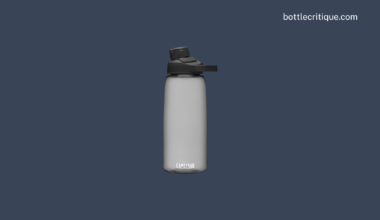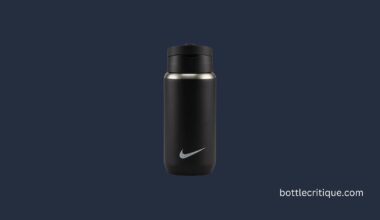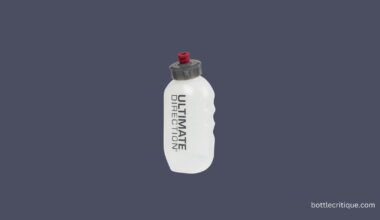Ever taken a sip from your water bottle only to be greeted by a soapy aftertaste? It’s a common problem many of us face. Cleaning our water bottles with soap is a simple and effective way to maintain hygiene, but it often leaves a pesky soap residue behind, spoiling the taste of the water. But don’t worry! We’ve got you covered with some simple, effective solutions to this dilemma. In this article, we’ll guide you step-by-step on how to remove soap taste from your water bottle. So let’s dive in and make your water bottle taste like, well, just water again!
Why does my water bottle taste like soap?
Ever taken a sip from your water bottle only to experience an off-putting soap flavor? You’re not alone! This typically occurs when soap residue remains in the bottle after cleaning.
Hand washing your water bottle or placing it in a dishwasher can sometimes leave behind tiny particles of soap. The tight spaces and corners in your bottle provide perfect hideouts for these residues.
Additionally, certain types of bottles, especially those made of plastic, may absorb the soap’s scent and taste during washing. The result? Your next drink tastes more like liquid dish detergent than refreshing water.
But don’t fret! There are effective methods to eliminate this soapy taste and smell from your water bottle. Keep reading to learn more.
The dangers of drinking soapy water
Have you ever wondered what could happen if you accidentally gulped down soapy water from your bottle? While drinking soapy water in small amounts is not typically harmful, repeated ingestion or consumption of larger quantities can pose some health risks.
Here are a few potential dangers:
- Stomach upset: Soapy water can irritate your stomach lining, leading to discomfort, nausea, or even vomiting.
- Diarrhea: Ingesting soap can disrupt your digestive system, causing diarrhea or loose stools.
- Chemical burns: Certain types of soap, especially those with high alkalinity, can cause mild to severe burns in the mouth, throat, and stomach.
Moreover, it’s worth noting that different types of soap come with different risks. For instance, antibacterial soaps can potentially disturb the balance of your gut microbiota, while harsh cleaning soaps may contain chemicals that are not meant for human consumption.
Therefore, it’s always a good idea to ensure you’re sipping on pure, clean water and not a soapy concoction. Not only does it taste better, but it also keeps you safe and healthy.
Knowing how to eliminate soap taste from your water bottle can go a long way in preventing these potential health hazards. So, how about we dive into the cleaning process?
Step-by-step guide to remove soap taste from water bottle
Ever taken a swig of water from your bottle, only to be met with a soapy aftertaste? It can ruin your hydration moment, right? But don’t worry! Let’s guide you through a simple process to remove this unwelcome flavor from your water bottle.
1. Rinse Thoroughly
First things first, give your bottle a good rinse with warm water. Do this immediately after washing it with soap to remove any remaining suds or soap residue. This is the easiest step and can often solve the problem.
2. Use Baking Soda
If a simple rinse doesn’t work, it’s time to bring out the big guns: baking soda. Baking soda is an excellent cleaner and deodorizer.
- Fill your bottle halfway with warm water.
- Add a few tablespoons of baking soda.
- Shake the bottle vigorously to dissolve the baking soda.
- Let the solution sit in the bottle for several hours or overnight for stronger soap taste.
- Rinse the bottle well with warm water.
3. Use Vinegar
If the soap taste still lingers after the baking soda treatment, vinegar can be a handy ally. While vinegar has a strong smell, it does not leave a residual taste when properly rinsed.
- Fill your bottle with equal parts of white vinegar and warm water.
- Shake the bottle and let it sit for a few hours.
- Rinse thoroughly with warm water until the vinegar smell is gone.
4. Store Properly
Last but not least, always store your water bottle with the cap off. This allows the inside to dry thoroughly, preventing the growth of taste-altering bacteria or mildew.
Remember, prevention is better than cure. Always rinse your water bottle immediately after washing to avoid a soapy taste. And if you find yourself faced with this issue, now you know what to do!
Happy hydrating!
Using vinegar to remove soap taste from water bottle
taste-free and ready for your next hydrating adventure. Here’s a step-by-step guide on how to do it:
Steps to Use Vinegar
- Fill Your Bottle with White Vinegar: First, fill your water bottle roughly halfway with white vinegar. The acidity of the vinegar will work to break down any soap residue lingering in your bottle.
- Add Warm Water: After adding the vinegar, fill the rest of the bottle with warm water. The warm water will help the vinegar spread and react more efficiently.
- Let It Sit: Cap the bottle and let the vinegar and water solution sit for about 15-30 minutes. This allows the vinegar to do its magic and dissolve any soap residue.
- Rinse Thoroughly: After the waiting period, rinse your water bottle thoroughly with warm water. Make sure to rinse multiple times to ensure all the vinegar has been washed out.
Remember, it’s crucial to rinse well after using the vinegar solution. Vinegar, while excellent at removing soap residue, has a strong taste that can linger if not rinsed out properly.
Post-Cleaning Check
Once you’ve completed these steps, take a moment to smell your water bottle. Does it still have the scent of soap or vinegar? If so, repeat the process. If not, you’re good to go!
Note: If you dislike the smell of vinegar, you can substitute it with baking soda. However, vinegar is generally more effective at removing soap taste because of its acidic nature.
In conclusion, using vinegar is an easy and effective method to remove the soap taste from your water bottle. So, don’t let the soap taste deter you from staying hydrated!
Using baking soda to remove soap taste from water bottle
soda, a common household item. Here’s how:
Materials Needed
- Baking Soda: Just a tablespoon will suffice!
- Warm Water: This aids in dissolving the baking soda efficiently.
Steps to Follow
- Empty your bottle: Ensure it’s completely void of any liquid.
- Prepare the solution: Dissolve one tablespoon of baking soda in a cup of warm water.
- Fill your bottle: Pour the baking soda solution into your water bottle.
- Shake it up: Secure the cap on your bottle, and give it a good shake for about a minute. This allows the solution to reach every part of your bottle.
- Let it sit: Leave the solution in the bottle overnight. This gives the baking soda ample time to neutralize the soap residue.
- Rinse thoroughly: Empty the baking soda solution and rinse the bottle with warm water several times to ensure all the baking soda is washed out.
There you have it, a clean, soap-free water bottle. Remember, if you still detect a soap taste after the first wash, repeat the process until the taste is completely gone. With this method, you can confidently take a gulp of water and enjoy the fresh, clean taste!
Using lemon juice to remove soap taste from water bottle
It’s an issue many of us have faced, and it can render our trusty water bottles practically unusable. But worry not! Lemon juice, a common household item, is an easy and effective solution to this problem.
Why lemon juice?
Lemon juice is a natural cleansing agent. The acidity in the juice acts to break down the soap residue that’s causing the bad taste. Plus, it leaves your water bottle with a fresh, citrusy scent!
Steps to use lemon juice:
- First, empty your water bottle and rinse it out with warm water.
- Next, fill the bottle halfway with warm water again.
- Then, squeeze the juice from half a lemon into the bottle. If you don’t have a fresh lemon, two tablespoons of bottled lemon juice will work just as well.
- Shake the bottle vigorously, ensuring the lemon juice and water mix well and cover all internal surfaces of the bottle.
- Leave the mixture in the bottle for about 15 minutes. This allows the lemon juice time to do its work.
- Rinse your water bottle thoroughly with warm water. Repeat a few times to make sure all lemon juice is washed out.
Remember, if the soapy taste persists after one round of cleaning with lemon juice, it might be necessary to repeat the process. If even after multiple attempts the taste remains, it may be time to consider getting a new water bottle.
Avoiding the soap taste in the future
To prevent the soapy taste from returning, rinse your water bottle thoroughly after each wash. Giving it a final rinse with hot water can be particularly effective. And, as tempting as it may be to use a lot of soap when washing, remember, less is more!
Using salt to remove soap taste from water bottle
Thankfully, there’s an easy solution. Salt can be a great ally in the fight against soap residue and the unpleasant taste it leaves behind. Let’s explore how we can use it.
Step 1: Rinse the Bottle Thoroughly
Firstly, rinse your water bottle with plain water. Make sure to wash it thoroughly, focusing on the corners and hard-to-reach areas where soap residue can hide.
Step 2: Prepare a Salt Solution
Next, prepare a salt solution. Dissolve 2 tablespoons of salt in one cup of warm water. This high concentration of salt will help to break down the soap residue.
Step 3: Swirl the Salt Solution
Pour the salt solution into your water bottle, then tightly close the lid. Shake it vigorously for a few minutes. The granules will scrub the interior surfaces, helping to remove any trace of soap.
Step 4: Let it Sit
Allow the salt solution to sit in the bottle for a few hours, or even overnight. This gives the salt ample time to react with any remaining soap residue.
Step 5: Rinse and Dry
Finally, rinse out the salt solution with warm water, and then leave your bottle to dry. Make sure it’s completely dry before you use it again to prevent any bacterial growth.
Tip: If you still detect a soap taste after following these steps, don’t worry. Just repeat the process. Sometimes, stubborn soap residue may require a second or even third round of cleaning.
So there you have it. Using salt isn’t just a simple but also an effective way to remove that unpleasant soap taste from your water bottle. Give it a try and enjoy a refreshing, clean-tasting drink!
How to properly rinse your water bottle
Believe it or not, the most effective way to get rid of a soapy aftertaste in your water bottle starts with a proper rinse. Let’s walk through the process.
Step-by-Step Process
- Empty the bottle: Start by emptying out any leftover water or soap residue in your bottle.
- Rinse with warm water: Fill the bottle halfway with warm water. Then, firmly cap the bottle and shake it vigorously. The warm water will help dislodge and dissolve any remaining soap.
- Empty and repeat: Pour out the warm water and repeat the process at least three times to ensure all soap residue is removed.
- Final Rinse: For the final rinse, fill the bottle completely with warm water and let it sit for a few minutes before emptying it.
Remember, the key to this process is repetition. The more times you rinse your bottle, the less likely it is that any soapy taste will remain.
Tips for an Effective Rinse
- Avoid hot water: Extremely hot water can warp or damage your bottle, especially if it’s made of plastic. Stick to warm water for the best results.
- Use a bottle brush: If your bottle has a narrow mouth or hard-to-reach areas, a long, thin bottle brush can be a big help in removing stuck-on soap.
With these steps and tips, you can ensure your water bottle is perfectly clean, soap-free, and ready for use. Happy Hydrating!
Preventing soap taste in your water bottle
taken a drink from your water bottle, expecting a refreshing sip, only to be greeted by an unpleasant soap taste? It’s a common issue that can be easily prevented with a few simple steps. Let’s dive right into how you can keep your water bottle tasting fresh and clean.
Proper Rinse After Washing
The first step to preventing a soapy taste is to make sure you’re thoroughly rinsing your water bottle after washing. Leftover soap residue is often the culprit behind that unwanted taste. So next time, rinse your bottle properly to ensure no soap remains.
Use the Right Soap
Not all soaps are created equal, especially when it comes to cleaning your water bottle. Using a mild, fragrance-free soap can greatly reduce the chances of leaving a residual taste. Avoid using dish soaps with strong scents or flavors.
Consider a Bottle Brush
Getting into those hard-to-reach spots in your water bottle can be a challenge, and soap can often linger in these areas. A bottle brush is a useful tool to ensure you’re thoroughly cleaning all parts of your bottle.
Regular Cleaning
Don’t let your water bottle sit dirty! Regular cleaning can help prevent the buildup of soap residue, keeping your water tasting fresh. Clean your bottle daily if you can, especially if you’re using it for drinks other than water.
Proper Drying
Lastly, make sure your water bottle is completely dry before using it again. Bacteria can grow in damp environments, which can also contribute to an unpleasant taste. Leave the cap off and allow your bottle to air dry after each wash.
By following these simple steps, you can ensure that your water stays tasting clean and refreshing, free from any soap-like taste. Happy hydrating!
Alternative water bottles to consider
Ever wondered if there are alternative options to your current water bottle that might not leave a soap taste? Well, there are indeed! Here’s a closer look at some of these options:
Stainless Steel Bottles
Stainless steel bottles are a popular choice among many due to their durability and resistance to retaining flavors. Unlike plastic bottles, they do not absorb the taste of the contents, which means no soapy aftertaste. Plus, they’re environmentally friendly too!
Glass Bottles
If you’re after the purest taste, then glass bottles might be right up your alley. Glass does not impart any flavors onto the water, ensuring a clean, crisp taste every time. However, do remember that they can be a bit fragile, so handle with care!
Ceramic Bottles
Ceramic bottles are another excellent alternative. Like glass, they do not absorb or impart any flavors, keeping your water taste as pure as possible. They’re typically more durable than glass, but are often heavier as well.
Remember, the key is to pick a bottle that fits your needs and lifestyle. Whether you prefer stainless steel, glass, or ceramic, each has its own set of pros and cons. Try them out and see which one works best for you!
“A water bottle is more than just a container; it’s a statement about who you are and your commitment to health and the environment.”

